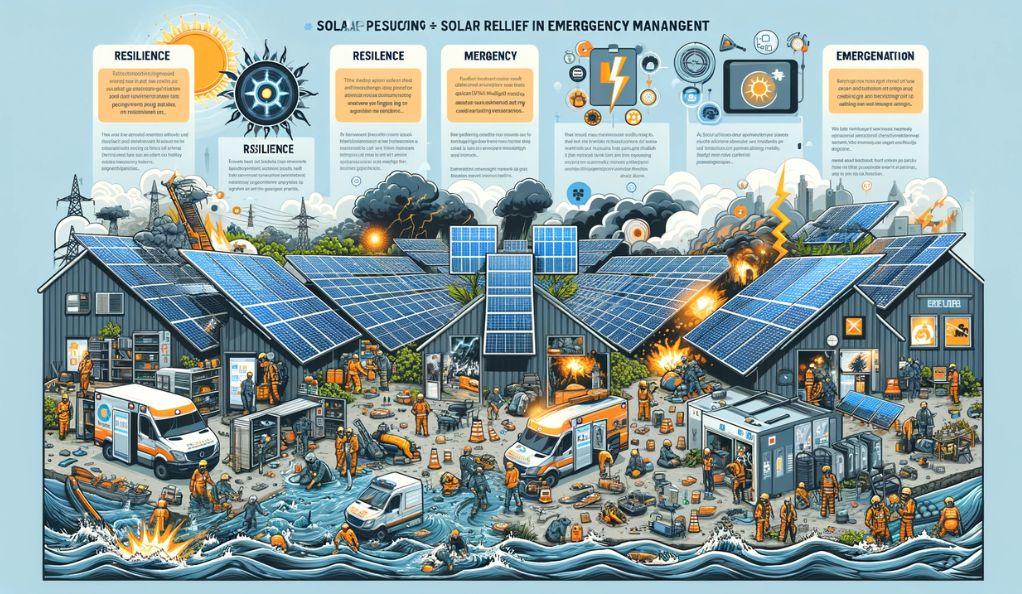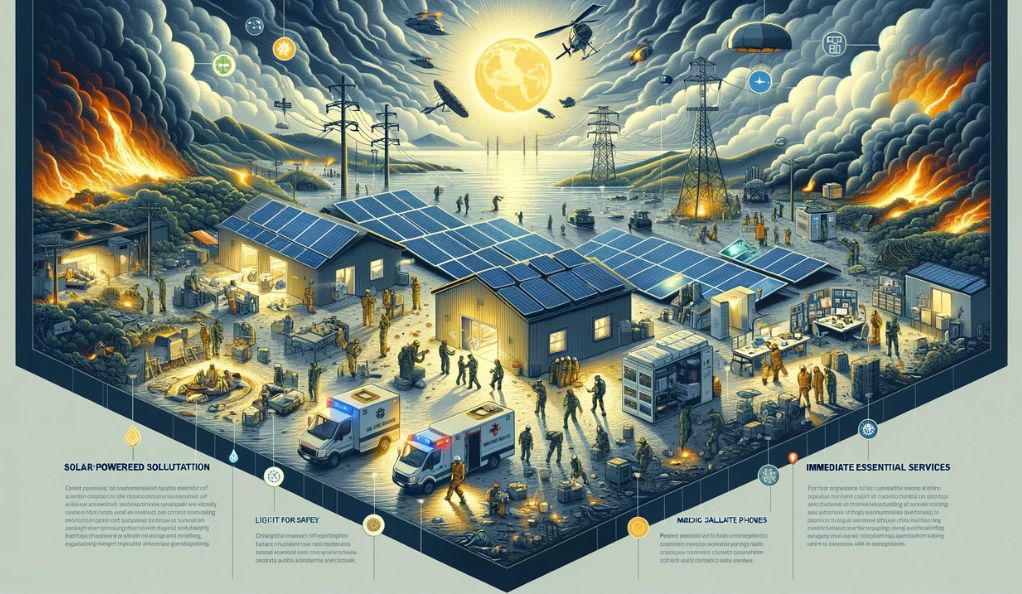Introduction to Solar Energy in Disaster Situations
In recent years, solar energy has emerged as a pivotal resource in disaster relief and emergency situations, offering a beacon of hope and resilience in the face of calamity. The role of solar power during these critical times extends far beyond mere energy provision; it represents a sustainable, reliable, and adaptable solution to the myriad challenges posed by natural disasters and humanitarian crises.
Harnessing the Sun’s Power in Times of Crisis
The utility of solar energy in disaster contexts lies in its inherent nature. As a renewable and ubiquitous resource, sunlight provides a consistent and accessible power source, especially when conventional energy infrastructures are compromised. Solar power systems, ranging from large-scale installations to portable units, can be rapidly deployed to provide essential services such as lighting, communication, medical support, and water purification.
Advantages of Solar Energy in Emergencies
One of the primary advantages of solar energy in emergency situations is its independence from traditional power grids. This characteristic is crucial in disaster-stricken areas where infrastructure is damaged or non-existent. Solar power systems can operate autonomously, supplying electricity to critical facilities like hospitals, emergency shelters, and communication centers even when traditional power sources are disrupted.
Furthermore, the versatility and portability of solar solutions offer significant benefits in challenging environments. Portable solar generators, panels, and chargers can be easily transported and installed in remote locations, providing immediate power for essential services. This portability is particularly valuable in areas where access to conventional fuel sources is hindered due to logistical challenges.
The Eco-Friendly Choice in Disaster Response
In addition to its functional benefits, solar energy is an environmentally friendly alternative to traditional fossil-fuel-based power sources. During emergencies, the use of diesel generators and other fossil fuel-based solutions not only poses logistical challenges but also contributes to pollution and carbon emissions. In contrast, solar power systems offer a clean, emission-free energy source, aligning with global sustainability goals and minimizing environmental impact during disaster recovery efforts.
The Resilience of Solar Power in Emergency Management

In the realm of disaster relief and emergency management, resilience is a paramount quality. Solar power systems have proven time and again that they possess the attributes necessary to provide unwavering support in the face of adversity. This section explores the critical functions sustained by solar energy during disasters and the importance of solar power in comprehensive emergency management plans.
Solar Power: A Beacon of Reliability
During a disaster, the reliability of energy sources becomes a matter of life and death. Unlike conventional power grids that are susceptible to damage and outages, solar power relies on an abundant and consistent resource: sunlight. Solar panels continue to generate electricity as long as there is sunlight, making them a steadfast source of power even in the most challenging circumstances.
Independence from Traditional Grids
One of the key advantages of solar power in disaster relief is its independence from traditional electricity grids. In the aftermath of a disaster, power grids are often compromised, leaving communities without access to electricity. Solar power systems, whether grid-tied or off-grid, can provide continuous electricity supply, ensuring that critical facilities remain operational. Hospitals, emergency shelters, and communication centers can rely on solar power to maintain essential services when traditional power sources fail.
The Solar Power Microgrid
A microgrid is a small-scale network of energy sources that can function autonomously or connect to the main grid as needed. In disaster scenarios, the use of solar microgrids has become increasingly common and effective. These microgrids are capable of providing power to isolated communities that are cut off from the grid due to natural disasters. They also play a pivotal role in reducing grid congestion and vulnerability by diversifying energy sources.
By incorporating solar microgrids into emergency management plans, communities can ensure a continuous supply of electricity, even when the broader grid infrastructure is compromised. This not only supports critical operations but also enhances overall resilience in disaster-prone regions.
A Clean and Eco-Friendly Choice
In times of crisis, environmental concerns often take a back seat to immediate survival and recovery efforts. However, the environmental impact of disaster response operations should not be overlooked. Traditional power sources, such as diesel generators, emit harmful pollutants and contribute to carbon emissions. In contrast, solar power is a clean and renewable energy source that produces zero greenhouse gas emissions during operation.
By utilizing solar energy in disaster response, we can mitigate the environmental impact of relief efforts. This not only protects the environment but also contributes to long-term sustainability goals. Solar power reduces dependence on fossil fuels that could further exacerbate the environmental challenges associated with natural disasters.
Advantages of Solar Energy in Disaster Preparedness
As we delve deeper into the role of solar energy in disaster relief and emergency situations, it becomes evident that solar power possesses a multitude of advantages that are pivotal in ensuring preparedness and effective response. This section explores these advantages, emphasizing the independence, portability, low maintenance requirements, and eco-friendliness of solar solutions.
Independence from the Grid
In disaster scenarios, the reliability of traditional electricity grids is often compromised due to damage or overloading. Solar power systems offer a distinct advantage by operating independently of the grid. Whether integrated into the main grid or designed as off-grid systems, solar panels can generate electricity without relying on external power sources.
This independence ensures a continuous supply of electricity, a critical factor in maintaining essential services during emergencies. Hospitals, emergency shelters, and communication centers can function without interruption, even when the grid is down.
Portability and Rapid Deployment
One of the defining features of solar power systems is their portability and ease of deployment. Solar panels, generators, and chargers can be quickly transported to disaster-stricken areas and set up with minimal effort. This mobility is particularly valuable in remote or hard-to-reach locations where conventional power sources may be unavailable or impractical.
Portable solar power units are designed to be compact, lightweight, and easy to assemble. They can provide immediate relief by supplying power for lighting, communication, medical equipment, and more. Rapid deployment of solar solutions is essential for saving lives and minimizing damage during the critical early stages of disaster response.
Low Maintenance Requirements
Once installed, solar power systems exhibit low maintenance requirements compared to traditional power sources. Solar panels have no moving parts and are designed to withstand various weather conditions, including extreme heat, cold, and precipitation. This durability reduces the need for frequent maintenance and ensures reliable long-term operation.
Maintenance of solar panels typically involves periodic cleaning to remove dust and debris that may accumulate on the surface. Additionally, routine inspections can identify and address any issues promptly. Overall, the minimal maintenance demands of solar power systems contribute to their cost-effectiveness in the long run.
Solar-Powered Solutions: Immediate and Effective Relief

In the aftermath of a disaster, the immediate restoration of essential services can be a matter of life and death. Solar-powered solutions offer a rapid and effective means of providing critical support to disaster-affected areas. This section explores the various applications of solar energy in disaster relief, highlighting its role in powering communication systems, providing lighting and safety, and supporting medical equipment and facilities.
Immediate Access to Energy
When disaster strikes, one of the most pressing challenges is the disruption of electricity grids. Power outages can have severe consequences, affecting everything from lighting and communication to medical equipment in hospitals. Solar power provides an immediate solution by harnessing energy from the sun. With the right infrastructure, relief organizations can quickly set up solar panels to generate electricity and ensure basic necessities are readily available.
Solar-powered lighting systems can illuminate darkened areas, improving safety and security for disaster survivors. Additionally, solar-charged batteries can power communication devices, allowing affected individuals to stay in touch with their loved ones and receive critical information. In this way, solar energy ensures that even in the darkest hours, there is a reliable source of light and communication.
Energy Independence
Solar power offers communities an opportunity to be self-sufficient even when the traditional grid infrastructure is disrupted. In disaster-stricken areas, the availability of fuel for generators may be limited or impractical to transport. Solar energy eliminates the dependence on fossil fuels and generators, ensuring a continuous power supply during and after disasters.
For remote and isolated areas that are difficult to reach, solar power is a lifeline. Portable solar units, including solar-powered generators and charging stations, can be rapidly deployed to provide essential power, lighting, and even clean drinking water. The mobility factor allows relief teams to target the areas most in need swiftly, ensuring that aid reaches those affected by the disaster in a timely manner.
Cost-Effective and Sustainable
Implementing solar power systems can significantly reduce operating costs for relief organizations. Solar panels have become more affordable over the years, and their maintenance costs are comparatively lower than traditional power sources such as diesel generators. Moreover, solar power aligns with sustainability goals, as it is a clean and renewable energy source.
The use of solar energy not only reduces immediate expenses but also contributes to long-term cost savings. By decreasing reliance on fossil fuels, relief organizations can reduce the financial burden of fuel procurement and transportation during emergencies. This cost-effectiveness allows resources to be allocated more efficiently, maximizing the impact of relief efforts.
Mobile Solar Solutions
In disaster-affected areas, mobility is often a key factor in relief operations. Mobile solar solutions, such as solar-powered generators and portable charging stations, have emerged as essential tools in disaster response. These self-contained units can be rapidly deployed to provide essential power, lighting, and even clean drinking water in remote locations where traditional infrastructure may be severely damaged or non-existent.
Solar-powered generators can supply electricity to critical facilities and equipment, including medical clinics and field hospitals. Portable charging stations offer a means for individuals to recharge their mobile phones and communication devices, helping them stay connected and informed. The versatility and mobility of these solar solutions make them indispensable in the early stages of disaster response when time is of the essence.
Long-Term Resilience
Solar energy not only addresses immediate relief needs but also contributes to long-term resilience in disaster-affected communities. By incorporating solar power into infrastructure planning and emergency response strategies, communities can reduce their reliance on fossil fuel-based energy sources.
In disaster-prone regions, the installation of solar panels on critical facilities and public buildings can ensure a continuous power supply, even during extended recovery periods. This long-term resilience helps communities recover more effectively and reduces their vulnerability to future disasters.
Conclusion
In the realm of disaster relief, solar energy has emerged as a game-changer, offering rapid and sustainable solutions. Solar power systems provide independence from grid failures, ensuring essential services remain operational. They are portable, cost-effective, and eco-friendly, making them ideal for disaster-prone areas. Real-world case studies highlight solar energy’s effectiveness in powering critical facilities, lighting, and medical equipment. As we look to the future, solar power’s sustainability, decentralization, and environmental benefits position it as a key tool in building resilient communities. Embracing solar energy in disaster management is a proactive step toward a more resilient and sustainable world. It offers hope and resilience in the face of adversity, ensuring that essential services are available when needed most. Solar power is not just a source of energy; it’s a beacon of hope for a brighter future.
